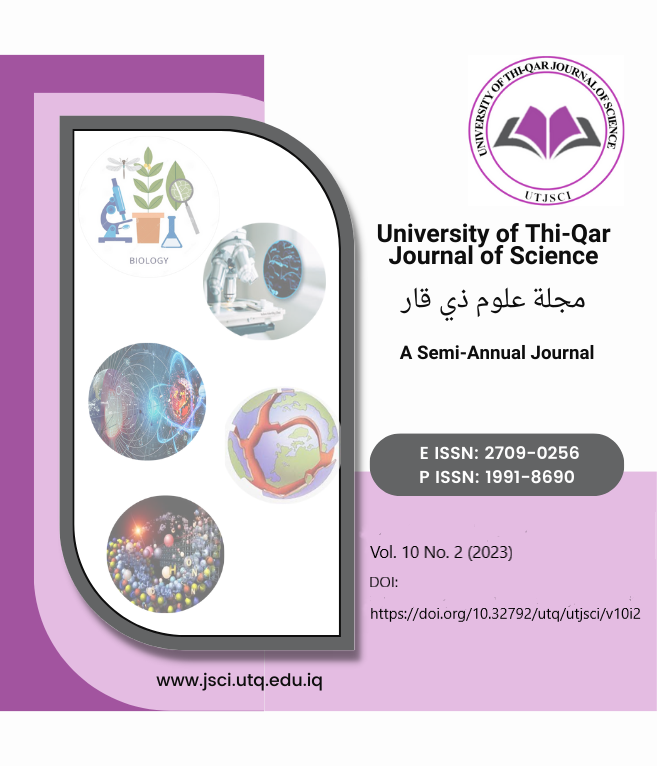Study of Soliton Interaction in Optical Fibers with Third Order Dispersion and Higher Order Nonlinear Effects
DOI:
https://doi.org/10.32792/utq/utjsci/v10i2.1114Abstract
In this paper, we present a numerical approach to solve the GNLSE and analyze soliton interaction phenomena using COMSOL environment. By leveraging the capabilities of COMSOL's PDE module, we can accurately capture the dynamics of solitons and investigate their interactions. We analyze the impact of different parameters such as soliton power, initial separation distance, and dispersion characteristics on the soliton dynamics. Furthermore, we examine the role of higher-order dispersion terms in shaping the soliton interactions. Our findings demonstrate the effectiveness of the proposed numerical approach in accurately simulating and analyzing soliton interaction phenomena. The COMSOL-based methodology provides a flexible and efficient framework for studying complex nonlinear optical systems, enabling researchers to gain insights into the behavior of solitons in different media and design optimized communication systems. This paper contributes to the understanding of soliton dynamics and provides a practical tool for investigating the behavior of solitons in nonlinear dispersive media. The presented numerical approach using COMSOL opens avenues for further research in nonlinear optics and fiber optic communication systems.
Received: 2023-09-10
Revised: 2023-09-30
Accepted: 2023-10-03
References
C. Mahnke, A. Hause, and F. Mitschke, “On the Creation of Solitons in Amplifying Optical Fibers,” International Journal of Optics, vol. 2018, pp. 1–11, 2018, doi: 10.1155/2018/9452540.
G. Agrawal, Applications of Nonlinear Fiber Optics. Elsevier, 2001.
P. Balla and G. P. Agrawal, “Nonlinear interaction of vector solitons inside birefringent optical fibers,” Physical Review A, vol. 98, no. 2, Aug. 2018, doi: 10.1103/physreva.98.023822.
G. P. Agrawal, “(Invited) Story behind the Nonlinear Fiber Optics book,” Optik, vol. 277, p. 170715, Apr. 2023, doi: 10.1016/j.ijleo.2023.170715.
J. H. Lee, J. van Howe, C. Xu, and X. Liu, “Soliton Self-Frequency Shift: Experimental Demonstrations and Applications,” IEEE Journal of Selected Topics in Quantum Electronics, vol. 14, no. 3, pp. 713–723, May 2008, doi: 10.1109/jstqe.2008.915526.
X. Yang, D. Huo, and X. Hong, “Periodic transmission and control of optical solitons in optical fibers,” Optik, vol. 216, p. 164752, Aug. 2020, doi: 10.1016/j.ijleo.2020.164752.
K. J. Blow and D. Wood, “Theoretical description of transient stimulated Raman scattering in optical fibers,” IEEE Journal of Quantum Electronics, vol. 25, no. 12, pp. 2665–2673, 1989, doi: 10.1109/3.40655.
L. Sirleto and M. A. Ferrara, “Fiber Amplifiers and Fiber Lasers Based on Stimulated Raman Scattering: A Review,” Micromachines, vol. 11, no. 3, p. 247, Feb. 2020, doi: 10.3390/mi11030247.
Y. Yu, W.-G. Jia, Q. Yan, N. Menke, and J.-P. Zhang, “Evolution of dark solitons in the presence of Raman gain and self-steepening effect,” Chinese Physics B, vol. 24, no. 8, p. 084210, Aug. 2015, doi: 10.1088/1674-1056/24/8/084210.
M. N. Saddam and M. I. Hasan, “Analytical Study of a Solar Hybrid Air-conditioning System Assisted Solar Absorption Using R-410A for Refrigeration Applications,” BOHR International Journal of Social Science and Humanities Research, vol. 1, no. 1, pp. 78–86, 2022, doi: 10.54646/bijsshr.012.
Modified Unequally Spaced Channels Wavelength Division Multiplexing System,” University of Thi-Qar Journal of Science, pp. 68–78, 2008, doi: 10.32792/thi/sc/vol.1.is.2.09.
[1]M. Mahboub and D. Bekhti, “Study of femtosecond soliton dynamics in photonic crystal fiber using the moment method,” Optik, vol. 125,
no. 16, pp. 4552–4556, Aug. 2014, doi: 10.1016/j.ijleo.2014.02.007.
C.-F. Chen, S. Chi, and B. Luo, “Femtosecond soliton propagation in an optical fiber,” Optik, vol. 113, no. 6, pp. 267–271, 2002, doi: 10.1078/0030-4026-00159.
C.-F. Chen, S. Chi, and B. Luo, “Femtosecond soliton propagation in an optical fiber,” Optik, vol. 113, no. 6, pp. 267–271, 2002, doi: 10.1078/0030-4026-00159.
J. M. Dudley, G. Genty, and S. Coen, “Supercontinuum generation in photonic crystal fiber,” Reviews of Modern Physics, vol. 78, no. 4, pp. 1135–1184, Oct. 2006, doi: 10.1103/revmodphys.78.1135.
H. Schroeder, S. A. Hosseini, Q. Luo, and S. L. Chin, “Self-steepening is an abrupt process,” Optics Communications, vol. 266, no. 1, pp. 302–306, Oct. 2006, doi: 10.1016/j.optcom.2006.04.033.
M. Mahboub and D. Bekhti, “Study of femtosecond soliton dynamics in photonic crystal fiber using the
moment method,” Optik, vol. 125, no. 16, pp. 4552–4556, Aug. 2014, doi: 10.1016/j.ijleo.2014.02.007.
R. Zhou, R. Huang, Q. Li, and H. Y. Fu, “Raman soliton at 2 μm in picosecond pumped supercontinuum by a weak CW trigger,” Optics Express, vol. 27, no. 9, p. 12976, Apr. 2019, doi: 10.1364/oe.27.012976.
J. M. Dudley, G. Genty, and S. Coen, “Supercontinuum generation in photonic crystal fiber,” Reviews of Modern Physics, vol. 78, no. 4, pp. 1135–1184, Oct. 2006, doi: 10.1103/revmodphys.78.1135.
J. C. Travers, “Blue extension of optical fibre supercontinuum generation,” Journal of Optics, vol. 12, no. 11, p. 113001, Oct. 2010, doi: 10.1088/2040-8978/12/11/113001.
“Analyses of Supercontinuum Generation in Photonic Crystal Fibers,” University of Thi-Qar Journal, Apr. 2019, Published, doi: 10.32792/utq/utj/vol11/4/4.
R. Driben and N. Zhavoronkov, “Effective Soliton Fusion Process at the Advanced Stage of Supercontinuum Generation in Photonic Crystal Fibers,” Optics and Photonics Journal, vol. 02, no. 03, pp. 211–215, 2012, doi: 10.4236/opj.2012.223032.
Downloads
Published
License
Copyright (c) 2023 University of Thi-Qar Journal of Science

This work is licensed under a Creative Commons Attribution 4.0 International License.













